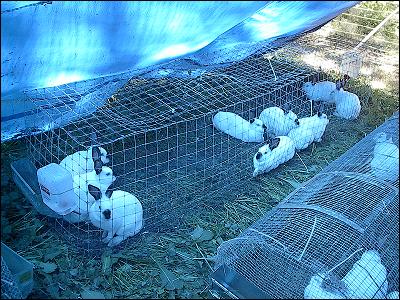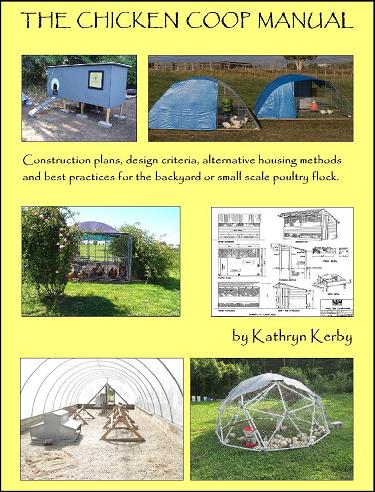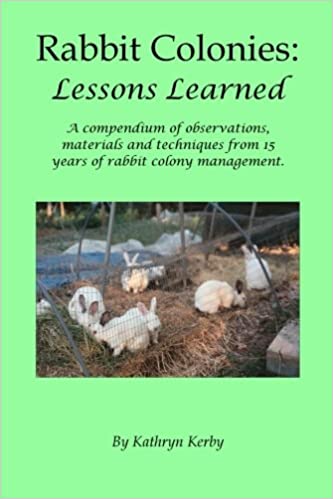|
Search this site for keywords or topics..... | ||

Custom Search
| ||
Rabbits On Pasture

Can a rabbit owner safely and cost-effectively keep rabbits on pasture?
Traditional livestock management has typically involved either part-time or full-time turnout on pasture. Turnout for most classes of livestock offers many advantages: distribution of manure over a wider area, self-harvest of fodder crops, time and space to engage in normal social interactions, and exposure to fresh air, sunlight and healthy environments. Keeping rabbits on pasture, however, has always been more of a challenge than with other livestock, for one very simple reason: rabbits love to dig. Dig they can, and dig they will. Rabbits are very well known to dig into all types of ground, anything from hardscrabble and compacted gravel, to lush mature pasture. Their digging disturbs the turf and creates hills, holes and even craters. If the ground had started out flat and level, it won't stay that way very long after rabbits have been on it awhile. Worse, they very commonly tunnel out from under any kind of known fencing, thus introducing two new problems - they gain their freedom away from protected areas, and they give small predators a ready highway into the rabbit yards. So, how can an owner successfully keep rabbits on pasture, without introducing any of these disadvantages?
Rotational Grazing
The two-part answer is surprisingly simple:
1) use rotational grazing, and
2) either put floors in the pens or lay fencing on the ground out in the field.
We'll cover the first part of this two-part answer here, and cover the second part further down on the page.
Many livestock owners are already familiar with the principles of rotational grazing. Rabbit owners who are just starting to think about keeping their rabbits on pasture, may not be as familiar with these principles. I'll give a very brief summary here, then provide additional resources at the bottom of this page. In general, rotational grazing keeps a relatively high density of animals on a small piece of ground for a very short time. Then those animals are moved to a new piece of ground. This proves to be a very cost-effective way to maintain both livestock populations and pasture land, for several reasons:
1) constantly moving animals to new ground almost eliminates the threat of internal parasites
2) moving animals to new grazing areas, ensures they always have access to fresh grass and other living plants.
3) moving animals off a well-grazed area allows that area to recover and regrow. Most pasture grasses evolved in a grazing environment, and are very well adapted to short-term intensive grazing, with long periods of recovery afterwards. In fact, most grasses are at their highest productivy when managed in this manner.
4) Predators are discouraged by the frequent moves, because they do not have a long period of time to "study" a pen and figure out its weaknesses. Each new move presents a new set of conditions which they have to figure out before gaining access. Move a pen frequently enough, and they never figure out how to get in.
5) For rabbits in particular, each new patch of ground is interesting enough and tasty enough, that their digging behaviors are minimized. Additionally, different pen designs may make it difficult or impossible to dig, thus eliminating one of the major challenges in keeping rabbits on pasture.
The above is just a minimal introduction to the many benefits of rotational grazing. Rabbit owners who are not yet familiar with this approach are encouraged to read more about rotational grazing so that they can really harness this approach and get the most out of it.
Field Pens with Floors
Now that we've talked about using rotational grazing for rabbits on pasture, let's talk about how to keep them where they belong. Many folks are familiar with the so-called chicken tractor, which is nothing other than a small, mobile chicken pen without a floor. The tractors allow poultry to live on pasture either during the day or all through the growing season, safe from predators and conveniently contained for easy management. The birds can peck and scratch and eat bugs and grass, then move to a new area before they turn their current area to mud. For rabbits on pasture, we can use the same idea with one of several slight modifications. One such modification is to put a layer of fencing along the pen floor, to completely enclose the pen. This approach is excellent if the ground is uneven, the grass is short, and the rabbits are large enough not to squeeze through gaps in the floor where the grass comes through. Various fence types which have openings up to 2" or even 4" in size, can work well with this approach. The one major disadvantage is that movement of the pen's bottom along the ground can sometimes flatten the grasses. The fence openings and grass height will determine how easily the grass can come through the openings, and/or how easily the rabbits can eat through the openings. The larger the opening, the more easily the rabbits can eat through it. But of course the openings should not be so large that the rabbits can start to dig and then squeeze through. When building such pens, owners will need to use a relatively large gauge wire, at least 14g, to ensure the wire is strong enough to hold a rabbit's weight, and large enough in diameter that the rabbit can't bite through it. Chicken wire does NOT work well for this purpose, because it's too lightweight. It will readily tear when moving, it'll rust through very quickly on even slightly damp ground, and the rabbits can bite through it.
We have used a slightly different approach, where we mow the grass short, lay down the fencing permanently, then let the grass grow back through the fence openings. We then either slide pens over the surface, or we simply put up additional standard fencing which is connected to the horizontal fence such that the rabbits can't squeeze out where the two fence panels meet. With either approach, rabbits can graze freely on the grasses and forbs that grow through the fencing, without tunneling out.
Many, but not all, types of fencing will work for either of these approaches. We started with conventional rabbit cage material, with 1"x2" openings. It proved to be very heavy and didn't allow much grass up through the openings. Our favorite so far is a 2"x2" mesh which is woven, not welded, at the points where the horizontal and vertical wires meet. This type of fencing comes in either 3' or 4' heights, by 50' long rolls. We simply roll out the fencing on the freshly mowed ground, then either erect permanent vertical fencing around the perimeter or slide pens along the surface. I have heard of others using 2x4 welded field fence but that doesn't stand up very long because the welds break. We have also experimented with chain link, but we found it too heavy and overly expensive. We liked the larger diameter wire, but the weave pattern meant that half the fence would always stick up a little bit off the ground, creating a trip and snag hazard.
All of the Advantages, Few of the Hassles
Using any of these methods, rabbits on pasture can offer a lot of advantages. The rabbits are out in the fresh air, their urine and manure is applied directly to the soil, they get fresh grass as part of their daily diet, and issues with a buildup of smell, disease organisms, manure and hair are all minimized or eliminated. We have managed whole litters on pasture, from weaning through harvest. We have also managed breeding trios on pasture, either in big permanent pens or in smaller mobile pens. As the does get ready to kindle and produce litters, we will pull them out, put them into small pens just long enough to kindle and bond with the kits, then put them outside again in separate grassy pens away from the adults. Others whom we have spoken to will put their pregnant does in mobile pens and include nesting boxes right in the pens. With either approach, the pens either need to be big enough that no one area becomes overgrazed, or the pens need to be moved to new ground before old ground becomes overgrazed and/or muddy and sodden. With both approaches, the kits then get the benefit of spending time on clean ground and eating fresh browse even before they are weaned.
Additional Considerations
Rabbits on pasture do require some additional consideration to avoid problems. To start with, having rabbits on pasture in direct sunlight can lead to overheating. Shade absolutely must be provided. On particularly hot, dry days, it may also be a good idea to provide fans or misters out in the pens. Or bring them into cooler indoor areas during the day and let them graze at night.
Rabbits also do not tolerate wet conditions. During our notoriously cool and damp spring and fall weather, we need to cover the pens sufficiently to provide protection against both direct and wind-driven rainfall. Pens which include wet areas need to be fenced off, or mobile pens need to be kept in well-drained areas. We do not graze in winter, because grass regrowth stops and the ground is simply too wet, too often, for rabbits to be comfortable and healthy. Also, the quality of the pasture itself will fluctuate over time, and will not always provide sufficient or balanced nutrition. Lactating does and growing kits demand the very highest nutrients from their pasture. If the pasture quality cannot meet those needs, they will weaken and die without supplementation. Conversely, non-pregnant, non-lactating does and infrequently non-breeding bucks can be maintained on less nutrient-rich pasture. Overly rich pasture might lead them to gain too much weight, while thin or poor pasture might be nutritionally deficient. So pasture resources must be assessed and monitored over time. Just as with other species, field and climate conditions must be monitored, and protection/supplementation provided as needed, to optimize the practice of keeping rabbits on pasture.
Additional Resources
A lot of colleges, small farm research organizations, sustainable farming and organic farminng groups, and animal welfare groups are looking into cost effective ways to keep rabbits on pasture. Here are several very nice sources of information from these various groups.
The Maine Organic Farmers and Gardeners Association has a very nice article about keeping rabbits on pasture for small-scale commercial production.
SARE provided funding for a small scale commercial rabbit producer name Julie Engel, to develop a system for keeping rabbits on pasture. SARE's article about her experiments and results, and ongoing management practices, gives a tremendous amount of been-there-done-that information to anyone else interested in the pro's and con's of this approach.
The Southern University Agricultural Research and Extension Center conducted a pair of field trials where young meat rabbits were raised on pasture, then compared with their caged counterparts in terms of mortality, yield, taste, tenderness and other meat qualities. Their research results shed some interesting light on what to expect from raising meat rabbits on pasture.
One family with a small homesteading operation, Vela Creations, has gone ultra-simple with rabbits on pasture by using standard rabbit cage mesh for their field pens. They graze rabbits in those standard cages as just one part of their overall rabbit management strategy. Their website has a Rabbit Mower page with several photos of their field pens, along with a nice write-up of how field pens fit into their overall rabbit management strategy.
Our Successful Farming and Ranching Books

We released our very first self-published book. The Chicken Coop Manual in 2014. It is a full color guide to conventional and alternative poultry housing options, including 8 conventional stud construction plans, 12 alternative housing methods, and almost 20 different design features. This book is available on Amazon.com and as a PDF download. Please visit The Chicken Coop Manual page for more information.

Rabbit Colonies: Lessons Learned
We started with rabbits in 2002, and we've been experimenting with colony management ever since. Fast forward to 2017, when I decided to write another book, this time about colony management. The book is chock-full of practical information, and is available from both Amazon and as a PDF download. Please visit the Rabbit Colonies page for more information.
The Pastured Pig Handbook
We are currently working on our next self-published book: The Pastured Pig Handbook. This particular book addresses a profitable, popular and successful hog management approach which sadly is not yet well documented. Our handbook, will cover all the various issues involved with pastured hog management, including case studies of numerous current pastured pig operations. If you have any questions about this book, please Contact Us.